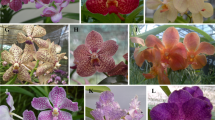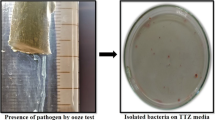Abstract
Eupatorium glandulosum of Asteraceae family is an important medicinal plant used to cure various diseases by tribal populace. In the present study, a protocol for mass propagation of Eupatorium glandulosum has been developed from nodal explants cultured in the MS basal medium supplemented with various concentrations and combinations of IAA and BA. The maximum rate of proliferation of shoots per explants (59.66 ± 1.76) was observed in the medium containing 0.5 mg/l of IAA and 3 mg/l of BA, but medium with 1 mg/l of IAA and 4 mg/l of BA showed the maximum shoot length. When the regenerated shoots were rooted in vitro on MS basal medium supplemented with various concentrations of IAA and IBA, medium with 4 mg/l of IBA induced more number of roots per shoot (32.67 ± 0.89) while maximum root length (6.1 ± 0.12 cm) was recorded in 3 mg/l of IBA. The plantlets, with well developed root systems, were successfully acclimatized and transferred to the pots containing a mixture of Soil, Sand and Coco peat (1:1:1) with 100% survival rate.
Key message
The research article tends to elucidate the tissue cultural techniques for the mass propagation and sustainable utilization of Eupatorium glandulosum. This technique could be implemented for the continuous extraction of valuable medicinal components in the pharmaceutical industry.

Similar content being viewed by others
References
Ansari S, Jain P, Tyagi RP, Joshi BC, Barar FSK (1983) Phytochemical and pharmacological studies of the aerial parts of Eupatorium adenophorum L. Herba Polonica 29(2):93–96
Avinash AA, Jaykumar JC, Nikhil BG, Rajaram VG, Ghansham BD, Shrirang RY (2019) In vitro regeneration approaches for restoration of Ceropegia mohanramii—an endemic and critically endangered asclepiad. J Genet Eng Biotechnol 17(2):1–5
Bantawa P, Rai R (2009) Studies on ethnomedicinal plants used by traditional practitioners, Jhankri; Bijuwa and Phedangma in Darjeeling Himalaya. Nat Prod Radiance 8(5):537–541
Chithra Devi B, Kamalam M (2007) In vitro propagation of an endangered medicinal plant—Nilgirianthus ciliates (Nees.) bremek. Phytomorphology 57(3):123–128
Dahanukar SA, Kulkarni RA, Rege NN (2000) Pharmacology of medicinal plants and natural products. Indian J Pharmacol 32(4):81–118
Deb CR, Deb MS, Jamir NS (2014) Effect of different factors on in vitro axillary shoot proliferation and plant regeneration of Cinnamomum tamala Nees: a spice yielding plant. Indian J Biotechnol 13:520–526
Deb CR, Imchen T (2010) An efficient in vitro hardening technique of tissue culture raised plants. Biotechnology 9(1):79–83
Dhavala A, Rathor TS (2010) Micropropagation of Embelia ribes Burm f. through proliferation of audult axillary shoots. Vitro Cell Dev Biol 46:180–191
Hussain SA, Naseem A, Mohammad A, Khalid RH (2019) Development of an efficient micropropagation system for Tecoma stans (L.) Juss. ex Kunth using thidiazuron and effects on phytochemical constitution. Vitro Cell Dev Biol 55(4):442–453
Kumar S (2002) The medicinal plants of North East India. Scientific Publishers, India, pp 88–90
Murashige T, Skoog F (1962) A revised medium for rapid growth and bioassays with tobacco tissue culture. Plant Physiol 15:473–479
Nithya V, Kamalam M (2018a) Comparitive pharmacognostical, phytochemical and antioxidant properties of three different Eupatorium species. Int J Pharm Biol Sci 8(3):883–891
Nithya V, Kamalam M (2018b) GC-MS analysis of leaf and callus extracts of Eupatorium glandulosum. Adv Appl Res 10(2):99–103
Nithya V, Kamalam M (2019) Estimation of quercetin content in three different species of Eupatorium by high-performance thin-layer chromatography. Int J Pharm Sci Res 10(1):303–308
Pandey P, Mehta R, Upadhyay R (2013) In-vitro propagation of an endangered medicinal plant Psoralea corylifolia Linn. Asian J Pharm Clin Res 6(3):115–118
Ramachandra RS, Ravishankar G (2002) Plant cell cultures: chemical factories of secondary metabolites. Biotechnol Adv 20(2):101–153
Revathi J, Manokari M, Latha R, Priyadharshini S, Mafatlal MK, Mahipal SS (2019) In vitro propagation, in vitro flowering, ex vitro root regeneration and foliar micro-morphological analysis of Hedyotis biflora (Linn.) Lam. Vegetos 32:609–619
Saha J, Prabir KS, Subrata C (2011) A survey of ethnomedicinal plants of Darjeeling hills for their antimicrobial and antioxidant activities. Indian J Nat Prod Resour 2(4):479–492
Shah SH, Ali S, Ali GM (2013) A novel approach for rapid in vitro morphogenesis in tomato (Solanum lycopersicum Mill ) with the application of cobalt chloride. Eur Acad Res 1(2):2702–2721
Sridhar TM, Naidu CV (2011) An efficient callus induction and plant regeneration of Solanum nigrum (L.)—an important antiulcer medicinal plant. J Phytol 3(5):23–28
Vasanthi S, Gopalakrishnan VK (2013) In vitro antioxidant, anti-acetylcholinesterase activity and GC-MS analysis of essential oil from flowers of Ageratina adenophora (Spreng). Res J Pharm, Biol Chem Sci 4(2):1419–1428
Yadav K, Groach R, Aggarwal A, Singh N (2015) A reliable protocol for micropropagation of Gloriosa superba L. (Colchicaceae). Asia-Pac J Mol Biol Biotechnol 23(1):242–251
Author information
Authors and Affiliations
Corresponding author
Additional information
Communicated by M. Paula Watt.
Publisher's Note
Springer Nature remains neutral with regard to jurisdictional claims in published maps and institutional affiliations.
Supplementary Information
Below is the link to the electronic supplementary material.
Rights and permissions
About this article
Cite this article
Nithya, V., Kamalam, M. Standardization of a protocol for micropropagation of Eupatorium glandulosum L. an important medicinal plant. Plant Cell Tiss Organ Cult 146, 339–344 (2021). https://doi.org/10.1007/s11240-021-02073-8
Received:
Accepted:
Published:
Issue Date:
DOI: https://doi.org/10.1007/s11240-021-02073-8




